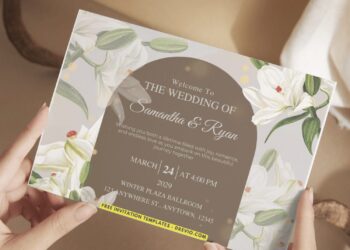Looking for creative ideas for gender-neutral invitations? Check out these tips and make all your guests feel welcomed and respected at your special event!
What are Gender-Neutral Invitations?
Are you looking to host an event that is inclusive and welcoming to all guests, regardless of their gender identity? Gender-neutral invitations may be the perfect solution for you! These invitations are designed to be free from any traditional gender norms or expectations, making them suitable for all individuals to attend and feel comfortable.
Gender-neutral invitations are invitations that do not specify any specific gender roles or expectations. Instead of using traditional language such as “Mr.” or “Mrs.” or “Bride” and “Groom,” gender-neutral invitations use more inclusive terms like “Host” and “Hostess” or “Celebrant 1” and “Celebrant 2.” These invitations are designed to be open and accepting of all individuals, regardless of their gender identity or expression.
When creating gender-neutral invitations, it’s important to pay attention to the language and imagery used. Avoiding stereotypes and assumptions about gender roles can help ensure that all guests feel welcome and included. Instead of using gender-specific colors or symbols, opt for neutral colors and designs that appeal to a wide range of individuals.
Gender-neutral invitations play a crucial role in creating a welcoming and inclusive environment for all guests. By using language and imagery that is free from traditional gender norms, you can show your guests that you value and respect their individual identities. This can help create a more positive and inclusive atmosphere for your event, where all guests feel comfortable being themselves.
Additionally, gender-neutral invitations can help challenge and break down harmful stereotypes and expectations surrounding gender. By embracing diversity and inclusivity in your invitations, you can set a positive example for others and help create a more accepting and understanding society.
What Symbols or Icons Can Be Used to Represent Gender Neutrality on Gender-Neutral Invitations?
- The Gender-Neutral Sign: One of the most commonly used symbols to represent gender neutrality is the gender-neutral sign. This symbol typically consists of a combination of both the male and female gender symbols, overlapped or combined in a unique way to signify inclusivity and neutrality.
- The Equality Sign: The equality sign, which consists of two parallel horizontal lines, is another powerful symbol that can be used to represent gender neutrality. This symbol emphasizes the idea of equality and inclusivity for all genders.
- The Human Figure: Another option for representing gender neutrality is to use a simple human figure icon. This can be a generic silhouette of a person that does not specify any gender characteristics, making it a versatile and inclusive symbol for gender-neutral invitations.
Practical Tips for Using Symbols on Gender-Neutral Invitations:
- Keep It Simple: When choosing symbols or icons for gender-neutral invitations, it is important to keep them simple and easy to understand. Complex symbols may confuse recipients and detract from the message of inclusivity.
- Consider Color Choices: The colors used for symbols on gender-neutral invitations can also affect their interpretation. Neutral colors like green, yellow, or gray are often associated with neutrality and inclusivity.
- Include Text Explanation: If using a less commonly known symbol for gender neutrality, it may be helpful to include a brief text explanation alongside the symbol on the invitation. This can ensure that all recipients understand the message being conveyed.
How Can You Ensure Your Gender-Neutral Invitations Feel Welcoming to All Genders?
- Use Inclusive Language: When creating your neutral-themed invitations, avoid using gender-specific terms like “Mr.” or “Mrs.” Instead, opt for gender-neutral terms like “Dear guests” or “Dear friends.” This simple change in language can make a big difference in ensuring that everyone feels included.
- Choose Gender-Neutral Colors: When selecting the color scheme for your invitations, opt for gender-neutral colors like green, yellow, or orange. Avoid using stereotypical colors like pink or blue, which may alienate individuals who do not identify with traditional gender norms.
- Avoid Gendered Icons: Stay away from using gendered icons or symbols on your invitations, such as dresses or suits. Instead, opt for universal symbols that do not reinforce gender stereotypes.
- Offer Gender Options: When addressing your invitations, provide options for guests to indicate their preferred title or salutation. Allow guests to choose from a range of titles, including “Mr.,” “Ms.,” “Mx.,” or simply their first name.
How Do You Choose a Gender-Neutral Invitation Theme That Avoids Gender Stereotypes?
It is essential to choose a gender-neutral invitation theme to create a welcoming and inclusive environment for all of your guests. Choosing a theme that avoids gender stereotypes ensures that everyone feels respected and valued, regardless of their gender identity. By selecting a gender-neutral invitation theme, you can help foster a sense of belonging and acceptance among all of your invitees.
When choosing a gender-neutral invitation theme, consider the following tips to ensure your invitations are inclusive and free from gender stereotypes:
- Use neutral colors: Opt for colors that are not traditionally associated with a specific gender, such as green, yellow, or purple. Avoid using pink for girls and blue for boys, as these colors can reinforce gender stereotypes.
- Focus on the event: Instead of basing your theme on traditional gender roles, focus on the purpose of the event. Whether it’s a birthday party, baby shower, or wedding, center your theme around the occasion rather than outdated gender norms.
- Incorporate diverse imagery: Choose images and graphics that represent a variety of genders and identities. Avoid using stereotypical images, such as princesses or trucks, and opt for more inclusive visuals that celebrate diversity.
- Use gender-neutral language: When writing your invitations, use language that is inclusive of all genders. Instead of using gendered terms like “he” or “she,” opt for gender-neutral language such as “they” or “guest of honor.”
How to Get Free Gender-Neutral Invitations?
Are you looking for gender-neutral invitations but don’t want to break the bank? Look no further! Our website offers a wide selection of free gender-neutral invitations for any occasion.
How to Access Free Gender-Neutral Invitations:
- Visit our website and navigate to the browse invitation section.
- Look for the filters or search bar to specifically select gender-neutral designs.
- Browse through the available options and choose the one that suits your event theme.
- Click on the desired invitation and customize it with your event details.
- Once you are satisfied with the design, download the invitation for free.
Personalizing Your Invitation:
After selecting your gender-neutral invitation, it’s time to personalize it to make it unique to your event. You can add details such as the event date, time, location, RSVP information, and any other pertinent details. Additionally, you can choose from various fonts, colors, and layout options to make the invitation truly yours.
How Can You Make Our Digital Gender-Neutral Invitations Feel More Inclusive?
Understanding Gender Neutrality
First and foremost, it’s crucial to have a clear understanding of what it means to be gender-neutral. Gender-neutral means that you are not identifying a person’s gender in a specific way. This can be achieved by using terms that are inclusive of all genders, such as “guest of honor” or “celebrated individual” instead of “Mr.” or “Mrs.” By avoiding gender-specific language, you are creating an invitation that is more welcoming to a diverse range of guests.
Using Inclusive Language
When creating your digital gender neutral-themed invitations, it’s important to use language that is inclusive and respectful. Avoiding gendered pronouns such as “he” or “she” and instead using gender-neutral pronouns like “they” can make a big difference in how your invitations are perceived. Using inclusive language shows that you respect all gender identities and creates a more welcoming atmosphere for your guests.
Offering Gender Options
One way to make your digital invitations more inclusive is to offer gender options for your guests to choose from. Instead of assuming someone’s gender, allow them to select their own gender identity from a list of options. This shows that you recognize and respect the diversity of your guests and value their individual identities.
Featuring Diverse Images
Another way to make your digital invitations more inclusive is to feature diverse images that represent a range of gender identities. Including images of people from different backgrounds, races, and gender expressions can help your guests feel seen and represented. By showcasing diversity in your invitations, you are sending a message of inclusivity and acceptance to all who receive them.
Providing Accessibility Options
In order to make your digital invitations truly inclusive, it’s important to provide accessibility options for guests with different needs. This can include offering text-to-speech options for visually impaired guests, providing alternate formats for those who may have difficulty reading traditional invitations, and ensuring that your invitations are compatible with screen readers. By making your invitations accessible to all, you are showing that you value and respect the diverse needs of your guests.
So, making your digital gender-neutral invitations feel more inclusive is not only important for creating a welcoming atmosphere for all guests but also for showing that you value diversity and inclusivity. By using inclusive language, offering gender options, featuring diverse images, and providing accessibility options, you can ensure that your invitations are respectful and welcoming to guests of all gender identities. So, are you ready to create invitations that truly embrace diversity and inclusivity?
Remember, it’s not just about sending out invitations – it’s about creating a space where everyone feels welcome and valued. By taking these simple steps, you can make a big difference in how your guests experience your event.






































